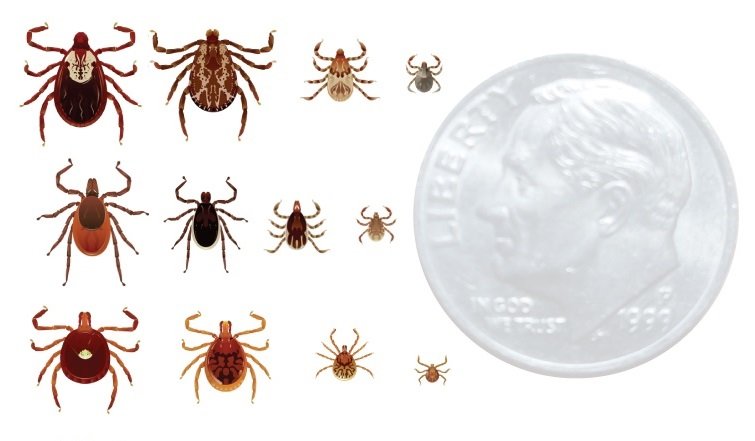
Ticks are tiny, blood-sucking parasites that can cause serious health problems in dogs. They live in tall grass, brushy and wooded areas where they can latch onto pets and feed on their blood.
Tick-borne diseases are a growing concern for dog owners as these illnesses can be hard to diagnose and treat.
ABOUT TICKS
Ticks are related to spiders and mites. They feed on the blood of mammals, birds, and reptiles and can spread diseases to people and animals.
There are several species of ticks that can vary in size from 1mm (about the size of a pencil tip) to 6mm. When feeding, sometimes for days, they will get larger as they gorge on blood. They can be green, brown, black, or white, depending on the type and age of the tick.
Some of the most common ticks that can affect dogs in the United States include the American dog tick, lone star tick, brown dog tick. and black-legged tick.
If you find a tick crawling on you or your dog, scoop it into a small jar filled with rubbing alcohol. Don't squish a tick because that could spread any disease it might be carrying. Not every tick is infected, but it's better to treat them like they are.

"This is a tick that was fully engorged on a dog and fell off. It was put in a ziplock bag and we waited to see what happened to show you all. It’s been in the bag for 2 weeks with no air flow and started to lay eggs about 5 days ago, continuing to do so even still today. Imagine not knowing this was on your animal and it fell off in your house. You’d have 1000’s of baby ticks. GROSS! Please make sure your animals are currently being treated with flea and tick prevention. We know how prevalent they are in our area."
TICK-BORNE DISEASES
Ticks spread disease by first feeding on an affected animal (or person) and later feeding on another animal (or person). When feeding, they insert their mouthparts into the host and drink the blood. Meanwhile, the tick's saliva enters the host, potentially spreading disease.
They can transmit several diseases to dogs, some of which can be life-threatening. The most common are:
Lyme disease:
Bacteria carried by black-legged ticks cause this disease. Symptoms include fever, joint pain, headache, fatigue, and loss of appetite. In some cases, Lyme disease can cause kidney damage, heart problems, and neurological issues. Lime disease is in the upper midwestern, northeastern, and mid-Atlantic states and also on the west coast. There is a vaccine for Lyme.
Signs and symptoms: The first symptom is often a circular rash at the bite site that slowly grows to about two inches in diameter. It's rarely itchy or painful. Other symptoms include fever, chills, and fatigue. Over time there may be additional rash sites and nerve damage that causes weakness and numbness.
Ehrlichiosis and Anaplasmosis:
Bacteria, carried by an infected tick, cause these infections. Lone star ticks carry ehrlichiosis, black-legged ticks carry anaplasmosis. Symptoms are similar and include fever, headache, chills, fatigue, loss of appetite, and joint pain. In severe cases, ehrlichiosis can cause anemia and bleeding disorders, and anaplasmosis can cause respiratory distress and neurological issues. Ehrlichiosis is in the southeastern and south-central states. Anaplasmosis is in the upper Midwest and northeastern states.
Signs and symptoms: fever, chills, fatigue, muscle pain, nausea, vomiting, diarrhea
Rocky Mountain Spotted Fever:
RMSF is a bacterial disease spread by an infected tick. Early symptoms include fever, headache, fatigue, stomach pain, and loss of appetite. RMSF is most common in North Carolina, Tennessee, Missouri, Arkansas, Oklahoma, and along the US-Mexico border, but it does occur in every state.
Signs and symptoms: rash, fever, fatigue, swelling around the eyes and hands, nausea, vomiting, diarrhea. Later there may be necrosis, trouble breathing, brain swelling, and coma.
If you think your dog may have a tick-borne disease, check with your veterinarian immediately.
Life Stages
Each row shows an adult female, adult male, nymph, and larva of a species.
Top row: American dog tick
Middle row: Black legged tick
Bottom row: Lone star tick
Image courtesy Cornell University

PROTECTING YOUR DOG
Take preventive measures to protect your dog.
Avoid Tick-Infested Areas:
Ticks are found in tall grass and wooded areas. To reduce your dog's risk of tick bites, avoid taking them to places where ticks are known to be present.
Keep Your Yard Clean:
To reduce your dog's risk of tick bites, keep your yard clean and well-maintained. Mow your lawn regularly and remove any leaf litter or debris that may provide a hiding place for ticks.
Use Tick Preventatives:
Several tick preventatives are available for dogs, including sprays, collars, tablets, and chews. These products kill ticks before they can attach to your dog's skin. Talk to your veterinarian about the best tick preventative for your dog.
Consider vaccinations:
There are vaccines for some tick-borne diseases, such as Lyme disease. Talk to your veterinarian about vaccinations recommended for your dog.
Check Your Dog For Ticks:
After spending time outdoors, thoroughly check your dog for ticks. Start by running your hands all over your dog. If you feel a bump, spread his fur to see if it's a tick. Be sure to check all the nooks and crannies - in and around his ears, eyelids, facial wrinkles, under collars, "armpits", groin area, and between his toes. Sometimes they'll even feed on your dog's gums. Another option is using a special tick comb to pull off ticks.
You can see a special comb used in this video.
If you find a tick, remove it using tweezers or a tick remover:
- Protect your skin with latex gloves.
- Using tweezers, pinch the tick close to your dog's skin and pull away from the skin in a steady motion. Don't twist or squeeze the tick because the head could break off.
- If you use a tick remover, slide it along your dog's skin until you catch it in the notch. Pull away in a steady motion.
- Place the tick(s) in a small jar and cover it with rubbing alcohol. Ask your veterinarian if you need to bring it in for identification.
- Wipe a cotton ball soaked in antiseptic over the bite area.
- Then keep looking because there may be more.
Check Yourself For Ticks:
Ticks can also latch on to people, so check yourself for ticks after spending time outdoors. You probably won't feel them on your skin or even when they bite and start feeding because they inject an anesthetic. If you find a tick, remove it immediately using tweezers or a tick remover detailed above.
If you live in, or are visiting, an area with lots of ticks, check your dog and yourself daily.
CONCLUSION
Tick-borne diseases are a threat to your dog's health. Taking preventative measures can reduce the risk of tick bites and tick-borne diseases.
Talk to your veterinarian about which tick preventatives are best for your dog.
Header image courtesy of Centers for Disease Control and Prevention





